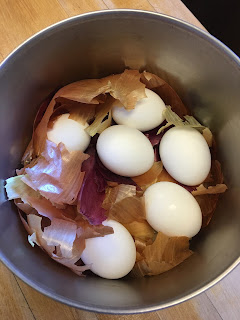Tangled roots and family secrets. A famous immigrant writer who died under mysterious circumstances. Accordions, polkas and potica. And now a new twist: My Year of Cooking Ethnically.
Saturday, December 25, 2021
Sunday, December 5, 2021
No-Knead Slovenian Rye Bread, Artisan style
This feels like a good time to share this overdue rye bread recipe. Thanks to my procrastination, it now coincides with an important cooking anniversary. Two years ago at this time, I discovered a popular artisan bread-making method that quickly became a pandemic mainstay and eventually crept into my Slovenian baking, including this recipe.
It was December 2019, during our last pre-pandemic holiday season. I wandered into a Christmas market sponsored by a local senior center and left with an intriguing cookbook called "Artisan Pizza and Flatbread in Five Minutes a Day." This was my introduction to the popular "Artisan Bread in 5" approach developed by Jeff Hertzberg and Zoë François in their ever-expanding collection of cookbooks and websites. Their master recipe for bread is a good place to start for anyone unfamiliar with their approach, which is based on bulk cold fermentation of a very soft dough that does not require kneading.
The recipe below is something of a hybrid. The foundation is a recipe from the 1950s cookbook published by the Progressive Slovene Women of America, who called it Quick Rye Bread--or rženi kruh na hitro, which translates as "rye bread in a hurry."
That vintage recipe felt surprisingly contemporary. For one thing, it called for a mix of rye, whole wheat and white flour, with the whole grains predominating. And the proportions in the recipe, including the flour/liquid balance, seemed identical to the new artisan breads I had been making. The only real difference (aside from the use of cake yeast in the older recipe) is that the artisan method recommends refrigerating the dough for at least two hours, and sometimes as long as two weeks, before baking. Along with the convenience of always having a supply of yeast dough on hand, the extended cold storage encourages the development of a more complex, fermented dough that comes to resemble sourdough.
So I decided to apply the artisan method to that older Slovenian American recipe. I refrigerated the dough for the minimum time suggested by the artisan people, because I wanted to have the bread ready by dinnertime. In theory, the dough could have been refrigerated for up to five days. Without whole grains, refrigerated dough can be safely stored for as long as two weeks, according to Hertzberg and François, so long as it is free of eggs or dairy products.
The bread was a success. It was flavorful and a little spongy, with none of the dense heaviness that whole grain breads sometimes have. It also made excellent toast. The next time, I might save half the dough for later to see how the flavor changes with longer storage. A sprinkle of caraway seeds would also add a nice touch.
Combine yeast, salt and sugar in a large bowl or container. Heat milk and butter and cool to lukewarm. Add to the large container and stir well. Combine the flours, add to the liquid ingredients, and stir until blended into a loose dough. Cover loosely and let rise for 2 hours at room temperature. Although the dough can be used at this point, it is easier to handle (and more flavorful) if it is refrigerated for at least 2 hours. When ready to bake, divide the dough into two small oiled loaf pans. (Or, if you prefer, save half the dough for up to five days and bake later.) Let the dough rise until doubled and bake at 375 degrees for 45 minutes to an hour. Remove from pan(s) and let cool before slicing.
Sunday, October 17, 2021
No More Mushy Buckwheat! (The secret is oven-toasting)
Tuesday, September 21, 2021
Quick Little Rye Honey Cakes
1/4 teaspoon vanilla
3 tablespoons dark brown sugar
5 tablespoons rye flour
1/4 teaspoon baking powder
1/4 teaspoon each cinnamon and ginger
2 pinches cloves or allspice
pinch of salt
In a small dish, melt butter in microwave. Add honey and beat with a fork. Add egg, brown sugar, and vanilla and mix well. Scoop flour into a measuring cup and mix in baking powder and spices. Add dry ingredients to the wet ingredients and mix until smooth.
Pour batter into two lightly greased ramekins and sprinkle a few walnut pieces on top. Cover with parchment paper. Microwave for 90 seconds and check cakes. If not yet firm, microwave for 10 seconds more and check again. Repeat if necessary. Let cool on a rack and unmold.
Tuesday, April 20, 2021
A Few New Twists on Onion Skin Eggs for Easter and Passover
Onion skins at last!
I couldn't believe my luck. Last year, I had to improvise, since we were having our groceries delivered, and there was no way to get a whole bag of onion skins.
But these year, now that I was vaccinated, I was starting to venture into local grocery stores. And in one small market, just as I walked in I discovered a man unloading a crate of onions, pulling off the skins, and placing the onions in a bin.
He was happy to oblige me with a small bag of the discards.
What a treasure in pandemic times!
I did my usual thing. I simmered the eggs for about three hours with a bunch of onion skins in water, salt and pepper, a chopped up clove of garlic (a new touch this time), and a little olive oil on top.
The project was on a smaller scale this year--and it was simplified. Just a half dozen eggs, and without the added decorative touches provided by those little leaves attached to the eggs with nylon. Call in pandemic burnout, but I just didn't have the time or energy.
That clove of garlic wasn't the only change. At my husband's suggestion, after simmering the eggs for about three hours and letting them cool off, I let them sit in the water overnight in the the fridge.The result was the deepest color yet.
The other change? I found a new use for hard-cooked eggs that are getting a little bit old. But that will have to wait for my next post!
Sunday, March 28, 2021
New Twists on Old Favorites: Jota with Sweet Potatoes and Balkan Cornbread with a Lift!
Where has the time gone?
My last post was a Christmas greeting back in December: The familiar gnome with a plate of potica and medenjaki. I had made those tasty spice cookies a little differently this year and had planned to follow up with the recipe. And now it is almost April. Funny how the same thing happened last year, right after our first pandemic Christmas, when I seemed to run out of blogging steam for three months.
No excuses, except to say that living and cooking through a pandemic is a new experience for all of us.
Now I have some catching up to do!
So here is a tasty dinner I made in early January. Two dependable favorites with a few new twists that worked out well.
Jota, Slovenia's traditional bean-and-sauerkraut stew, has become one of our favorite comfort foods, especially after I arrived at my new and improved version. We had almost everything on hand--including some garlic sausage (made with chicken, our preference) and homemade sauerkraut, courtesy of my husband. We were missing just one ingredient: Potatoes. Unless you count sweet potatoes. Which I did.
My husband had his doubts, but those sweet potatoes turned out to be more than just a good substitute. They added a touch of sweetness and color that provided a whole new dimension to the dish.







